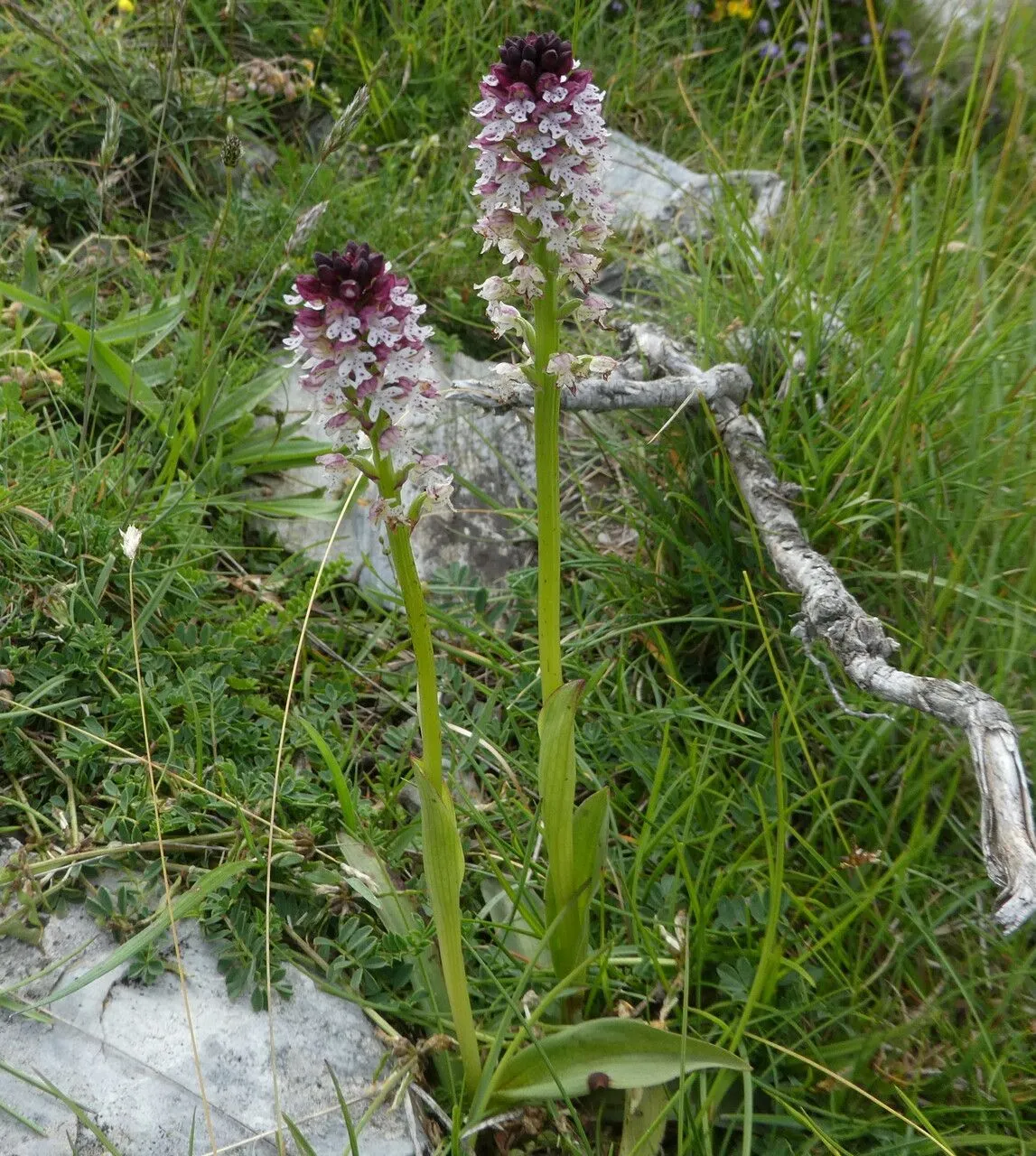
Author: R.M.Bateman, Pridgeon & M.W.Chase (L.)
Bibliography: Lindleyana 12: 122 (1997)
Year: 1997
Status: accepted
Rank: species
Genus: Neotinea
Vegetable: False
Observations: Europe to Caucasus
The Burnt Tip Orchid, scientifically known as Neotinea ustulata, is a captivating member of the Orchidaceae family. This diminutive yet striking plant is easily distinguished by its unique appearance and intriguing lifecycle.
Characterized by its petite and densely packed flower spikes, the Burnt Tip Orchid derives its common name from the distinctive dark, almost burnt-looking, tips of its unopened buds. This striking feature contrasts beautifully with the delicate white petals marked with crimson speckles that emerge when the flowers bloom.
Endemic to a broad geographical range extending from Europe to the Caucasus, Neotinea ustulata thrives in diverse environments, from lowland grasslands to mountainous meadows. It prefers well-drained calcareous soils, often flourishing in areas with minimal human disturbance.
The lifecycle of this orchid is as fascinating as its form. Blooming takes place from late spring to early summer. The plant relies on a symbiotic relationship with mycorrhizal fungi to obtain nutrients, a characteristic feature of many orchid species.
Another compelling aspect of the Burnt Tip Orchid is its pollination strategy. The flowers emit a subtle, sweet fragrance that attracts a range of pollinating insects, including bees and butterflies. This interaction ensures successful fertilization and the continuation of its species.
Historically, this species has been the subject of botanical interest, with substantial contributions from renowned botanists. In 1997, it was comprehensively documented in Lindleyana, further cementing its significance within the scientific community. Prominent researchers like R.M. Bateman, Pridgeon, and M.W. Chase have delved into its intricate characteristics, revealing the complexities and beauty of this remarkable orchid.
In conclusion, the Burnt Tip Orchid (Neotinea ustulata) is a fascinating and picturesque orchid that captivates botanists and nature enthusiasts alike. Its distinctive physical characteristics and intricate ecological interactions make it an exemplary species within the Orchidaceae family, contributing to the rich biodiversity of the regions it inhabits.
De: Schwärzliche Orchis, Brand-Knabenkraut, Schwarzköpfige Orchis, Brand-Orchidee
It: Orchide bruciacchiata, Sipho macchiettato
No: Krutbrænner
Nb: Kruttbrenner
Nn: Krutbrennar
Sk: Neotinea počerná
Sv: Krutbrännare
Cy: Cordegeirian, Tegeirian Llosg, Tegeiriau Llosg
Cym: cordegeirian, tegeirian llosg, tegeiriau llosg
En: Burnt tip orchid, Burnt orchid, Burnt-tip Orchid, Dwarf orchid, Orchids, Dark-winged orchis
Ca: Orquis socarrat
Da: Bakke-gøgeurt, Bakkegøgeurt, Rubladet gøgeurt
Nl: Aangebrande orchis
Fr: Orchis brûlé, Orchis mignon
Dan: bakke-gøgeurt, bakkegøgeurt, rubladet gøgeurt
Swe: krutbrännare
Nor: krutbrænner
Nld: aangebrande orchis
Eng: burnt orchid, burnt-tip orchid
Nno: krutbrennar
Nob: kruttbrenner
Taken May 24, 2021 by Stéphane Mars (cc-by-sa)
Taken Aug 15, 2021 by Nathalie Bonvarlet (cc-by-sa)
Taken May 23, 2021 by Nora Arteta (cc-by-sa)
Taken May 28, 2021 by Llandrich anna (cc-by-sa)
Taken May 28, 2021 by Llandrich anna (cc-by-sa)
Taken May 5, 2021 by Gui ferl (cc-by-sa)
Taken May 23, 2020 by chiaralaterra (cc-by-sa)
Taken May 27, 2022 by Philippe Bissières (cc-by-sa)
Taken May 24, 2021 by Stéphane Mars (cc-by-sa)
Taken Jun 21, 2020 by Llandrich anna (cc-by-sa)
Taken Jul 21, 2010 by Tela Botanica − Yoan MARTIN (cc-by-sa)
Taken Jul 19, 2014 by Tela Botanica − Yoan MARTIN (cc-by-sa)
Taken Jun 11, 2022 by Mieke D’hondt (cc-by-sa)
Taken May 8, 2021 by Daniel Bourget (cc-by-sa)
Taken May 27, 2022 by Philippe Bissières (cc-by-sa)
Taken May 15, 1998 by Photoflora – Benoit BOCK (©)
Taken May 15, 2010 by Photoflora – Benoit BOCK (©)
Taken Apr 30, 1875 by Tela Botanica − Herbier PONTARLIER-MARICHAL (cc-by-sa)
Taken Jun 30, 2018 by Alena Habustova (cc-by-sa)
Taken Jun 2, 2022 by Llandrich anna (cc-by-sa)
Taken May 26, 2022 by Christophe Bourdillon (cc-by-sa)
Taken Apr 22, 2017 by Geneviève Perello (cc-by-sa)
Taken Jun 12, 2021 by Jose Maria Treviño Ferrer (cc-by-sa)
Taken Jul 15, 2012 by Tela Botanica − Yoan MARTIN (cc-by-sa)
Taken Jul 16, 2016 by Tela Botanica − Yoan MARTIN (cc-by-sa)
Taken Jul 15, 2013 by Photoflora – Jean-Luc TASSET (©)
Taken Jul 15, 2016 by Tela Botanica − Yoan MARTIN (cc-by-sa)
Taken Jul 15, 2016 by Tela Botanica − Yoan MARTIN (cc-by-sa)
© copyright of the Board of Trustees of the Royal Botanic Gardens, Kew.
© copyright of the Board of Trustees of the Royal Botanic Gardens, Kew.
© copyright of the Board of Trustees of the Royal Botanic Gardens, Kew.
Ph maximum: 7.0
Ph minimum: 6.5
Light: 7
Atmospheric humidity: 4
Soil nutriments: 3
Family: Myrtaceae Author: (F.Muell.) K.D.Hill & L.A.S.Johnson Bibliography: Telopea 6: 402 (1995) Year: 1995 Status:…
Family: Rubiaceae Author: Pierre ex A.Froehner Bibliography: Notizbl. Bot. Gart. Berlin-Dahlem 1: 237 (1897) Year:…
Family: Sapindaceae Author: Koidz. Bibliography: J. Coll. Sci. Imp. Univ. Tokyo 32(1): 38 (1911) Year:…
Family: Asteraceae Author: A.Gray Bibliography: Pacif. Railr. Rep.: 107 (1857) Year: 1857 Status: accepted Rank:…
Family: Fabaceae Author: Medik. Bibliography: Vorles. Churpfälz. Phys.-Ökon. Ges. 2: 398 (1787) Year: 1787 Status:…
Family: Aspleniaceae Author: (Cav.) Alston Bibliography: Bull. Misc. Inform. Kew 1932: 309 (1932) Year: 1932…